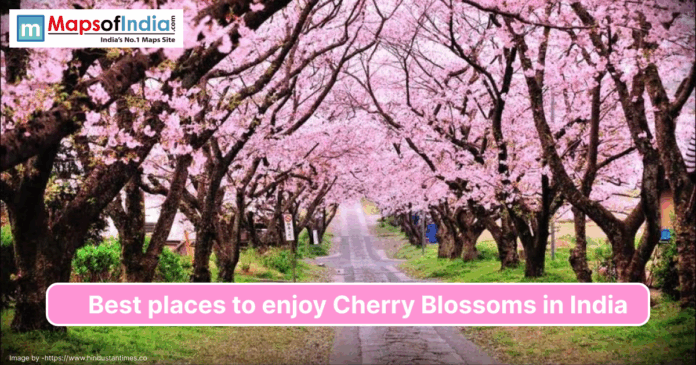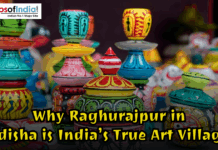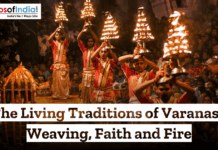There are Cherry blossoms that happen in India also, which transform India’s landscapes. This is known as Prunus cerasoides. They bloom in vibrant pink hues. These cherry blossom trees are found in the Himalayas and the Northeast, and they signal spring’s arrival. There are many festivals that celebrate their fleeting beauty. Many tourists visit these places, making it one of the most popular tourist places in India. Over 500000 tourists visit these blooms yearly, according to a 2024 Economic Times article. Their short season heightens their allure.
Shillong: Meghalaya’s Cherry Blossom Haven
Shillong is known as India’s cherry blossom capital. The International Cherry Blossom Festival took place here in November. According to the StayVista Journal report, more than 50000 people attend this festival. This is inspired by Japan’s Sakura. It has a blend of music and culture. These cherry blossoms cover Umiak Lake and Ward’s Lake. The pink cherry petals carpet the city streets. There is a 20% tourism growth each year. Local bands and food stalls add vibrancy to this festival. October to November is the peak season to witness the marvel of this place. Mild weather enhances views. To attend this festival, fly to Shillong Airport from Delhi in 2.5 hours. Taxis reach the city in 30 minutes. Walk on the Laitumkhrah trails for gorgeous photos. Shillong’s blossoms create a dreamy escape. It’s a must-visit for flower enthusiasts.
Gangtok: Sikkim’s Himalayan Pink Splendour
Gangtok, the capital of Sikkim, dazzles with cherry blossoms. This city blooms with cherry blossoms from March to April. At that time, there were 337 bird species amid flowers. Blossoms cover Kanchenjunga’s majestic peaks. Rumtek and Enchey Monasteries are prime spots to catch the breathtaking view. Pink petals contrast with lush green hills. You can witness 50 kilometres of roads bloom. The state plants 1000 trees each year. At dawn, you can get the clearest views of the blossom. Clear skies highlight vibrant colours. Fly to Bagdogra Airport and from there drive 124 kilometres. Foreigners need permits to visit some places. To catch the view of blossoms, Trek to Nathu La Pass. Pack warm layers for a 3500-meter altitude. Gangtok blends serenity and spirituality. It’s a Himalayan gem for blossom seekers.
Kohima: Nagaland’s Cultural Blossom Hub
Kohima, Nagaland‘s cultural blossom hub, glows with cherry blossoms. The pink waves struck Nagaland’s capital in November. The well-known Hornbill Festival coincides with cherry blooms. This is one of the top destinations visited by many tourists. Japanese cherry trees line city roads. Dzükou Valley nearby bursts with wild blossoms. According to the Economic Times article, there are more than 10000 trees planted. The festival attracts 200000 visitors each year. Naga dances and crafts enrich your visit. Late October to December is an ideal time to visit this place. Cool weather enhances the spectacle. Inner Line Permits are mandatory for tourists. Hike Japfü Peak for panoramic pink vistas. Pack rain gear for preventing sudden showers. Kohima’s blossoms celebrate Naga heritage. You will witness a cultural and natural marvel at this place.
Shimla: Himachal’s Colonial Blossom Charm
Shimla’s cherry blossoms have a nostalgic charm. In the march to April, The Ridge and Mall Road bloom with cherry blossoms. A recent TravPedia report ranks this place among India’s best. Pink flowers cover the snow-capped Himalayas. Christ Church and Viceregal Lodge remind us of colonial flair. A CN Traveller article says 5000 trees dot Shimla. During the peak season, blossoms draw 100000 tourists each month. Spring festivals like Holi come together with blooms. Stroll Mall Road to get vibrant blooms. It can get sunny, which will enhance the view of the blossoms. Shimla’s blossoms blend history and nature. It’s a romantic retreat for couples.
Manali: Adventure Amid Pink Petals
Manali gives you adventure with the pink petals. Orchards here burst with cherry blossoms. During April, this Himachal town became pink. This place provides visitors a scenic trails. In Manali, apple and cherry trees line Solang Valley. Rohtang Pass offers high-altitude blooms. According to the Times of India article, this cherry blossom land has 500 hectares of bloom. Adventure lovers paragliding through the petals. Blossoms coincide with apple flowering. Early April brings mild weather. You can enjoy many various things here, like a Trek to Jogini Falls through blossoms. Pack warm clothes for chilly 2050-meter nights. Manali’s blooms fuel outdoor thrills. It’s ideal for active travellers.
Munsiyari: Uttarakhand’s Secluded Blossom Retreat
Munsiyari gives Uttarakhand’s secluded blossom retreat offering offbeat cherry blossom views. This Uttarakhand gem blooms from March to April. This place is praised for its solitude. Panchachuli peaks frame pink valleys. Milam Glacier trails are covered with blossoms. According to the Down to Earth article, in this place, more than 200 cherry trees thrive. Himalayan Monal birds complement the viewing experience. The peak season sees 10000 visitors. Dawn brings mist, providing a magical view to visitors. To reach this place, fly to the nearest Airport. Jeeps are here to help you navigate through rugged roads. Hike to the Khaliya Top through pink panoramas. Pack woollens for a 2200-meter altitude. Munsiyari’s blossoms offer peace. It’s a haven for nature lovers.
Tawang: Arunachal’s Spiritual Blossom Sanctuary
Tawang, Arunachal‘s spiritual blossom sanctuary, rivals Japan’s Sakura. Arunachal’s monastery town blooms from March to May. Visitors describe this place as breathtaking. Blossoms encircle Tawang Monastery, which is Asia’s second-largest. Sela Pass trails glow with pink paths. An Outlook Traveller article mentioned that there are more than 1000 cherry blossom trees planted. The India International Cherry Blossom Festival attract more than 5000 tourists. April has clear skies for viewing. Visit Bum La Pass to witness the spectacular view of high-altitude blooms. Pack thermals for 3048-meter cold. Tawang’s blossoms merge faith and beauty. It’s a spiritual escape.
Conclusion
India’s cherry blossoms are a natural spectacle. Cherry blossoms symbolise fleeting beauty. In India, they bloom for just weeks. Many festivals celebrate renewal. Shillong’s event alone draws 50000 visitors across the globe. In 2025, 500000 tourists visited these places. An Economic Times article notes 20% tourism growth each year. The surge of tourists in the blossoming season boosts local economies. Kashmir’s cherry orchards generate Rs. 100 crore yearly. States plant more trees for eco-tourism. Warmer winters delay blooms by 10 days. Sanctuaries protect native species. Festivals foster cultural exchange. India’s Sakura rivals Japan’s. These pink waves inspire awe and unity. They draw poets, photographers, and travellers.




